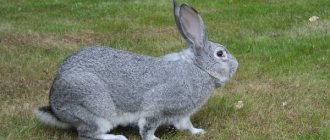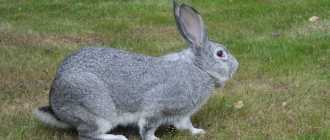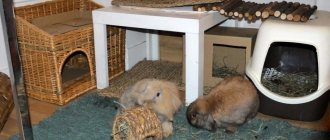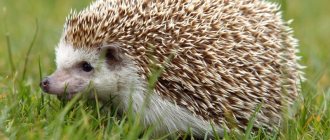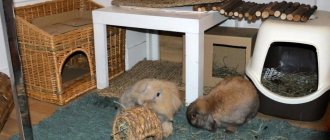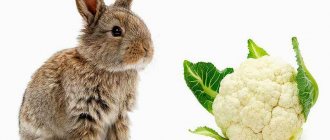When deciding to raise rabbits, novice farmers try to choose a breed that would simultaneously meet high food characteristics, be fertile, and be well adapted to breeding conditions.
The California rabbit meets all these indicators. These unpretentious large animals were bred precisely in order to learn the basics of rabbit breeding in the process of caring for them.
Origin story
This type of rabbit is native to the state of California in the USA. Initially, the animals were hybrids that were bred by crossing several breeds - New Zealand White, Soviet Chinchillas, Russian Ermine.
The main goal of the work was to obtain a unique species capable of rapid growth and high quality fur. Scientists have developed a Californian species that produces tasty, high-quality and tender meat. In 1928, this species was recognized as independent, and animals were no longer considered hybrids.
In the 70s, the described breed was brought to the territory of our country. The animals easily adapted to living in central Russia. Today they are actively bred both on large farms for industrial purposes and on small farms. Such actions had a direct impact on the rapid spread of this species throughout the entire globe.
Today, Californians take second place among the most popular meat types.
External features
The main characteristics by which the described breed can be identified are:
- body shape is cylindrical;
- outwardly it seems that the animal does not have the largest shape;
- paws of medium length, slightly thick;
- dense and thick fur, printed;
- small neck;
- the ears are not very long;
- small head, not heavy;
- red eyes;
- The fur is almost entirely white, but the paws, nose and tail are dark brown.
It is rare to find animals of a smoky blue or chocolate color. Breeders who do not have sufficient experience may confuse this species with Butterfly rabbits. In order not to confuse these two similar breeds, special attention is paid to the muzzle - the butterflies have dark eyes and a small spot on the nose, similar to a moth that has spread its wings.
Young individuals do not immediately show spotting. Rabbits are often found at a young age with a light or lilac-blue color, but over time the characteristic features of the breed become more clearly visible.
Buy young animals only from experienced breeders who will not deceive you.
Breed characteristics
The Californian breed is considered an industrial breed, but it is also possible to keep such rabbits on private farms. Of course, animals can grow more slowly, but if they are not raised for meat, this indicator does not play a special role. Representatives of the described breed will also make excellent pets.
Character and behavior
Californians are distinguished by their calm and flexible character. Even when they find themselves in an unfamiliar place, they remain calm and experience virtually no stress. However, the animals are very active and inquisitive, so they cannot be called apathetic.
Their character is soft and they quickly become attached to a person. They are very playful, which is why Californians often become pets. They have high intelligence, but they have one peculiarity - the animals love to chew on everything. Therefore, you need to take care in advance to ensure that animals do not damage furniture or expensive items in the apartment. While walking around the apartment, the rabbit needs to be constantly monitored.
Females become caring mothers who can independently care for their young. No additional human assistance is required. They can also be given to other people's rabbits, which the females begin to actively care for if they are in the same cage.
Productive qualities
Californians have excellent productivity, so the breed is often chosen by professional farmers. The weight of a mature individual is approximately 5.8-6 kg. Intensive growth occurs and at the age of 5-6 months the animals can be sent for slaughter. The baby rabbit weighs about 50 g, but after 2 months it reaches a weight of 2 kg. The milestone age is considered to be 7 months and is the final age, since active growth stops.
The ratio of fat and meat is at a good level, which makes this species more profitable for development. You can get about 80% quality meat and about 2% fat.
One female gives birth to about 8-14 young rabbits. They have a high level of maternal instinct and excellent milk production. All this contributes to the rapid growth of young animals. Over the course of a year, one female rabbit will produce no more than 35 rabbits.
There is a density index, according to which the productivity of the breed is assessed. For California rabbits, this figure is approximately 60%. This is the maximum for meat types.
Growing this breed requires minimal financial and time investments, but productivity is at the highest level.
Californian rabbit weight table by month
Depending on the age of the rabbit, its weight will also change. Below is an approximate table of how an animal’s weight increases as it grows:
| Rabbit age | Weight, kg |
| Newborn baby rabbit | 0,6 |
| One month | 0,9-1,1 |
| Two month | 1,5-1,8 |
| Three months | 1,8-2,6 |
| Four months | 2,6-3,5 |
| Five months | 3,5-3,7 |
| Six months | 3,9-4,2 |
| Seven months | 4,5-6 |
Advantages and disadvantages
The described breed has many advantages, including:
- from 5 months the animals are ready for breeding;
- females are characterized by excellent milk production and good maternal instinct;
- it takes a minimum amount of time for a rabbit to reach its maximum weight;
- high fertility - one female per year can give birth to up to 35 rabbits;
- high genetic stability.
The main disadvantage of Californians is sensitivity to diet and feed. Therefore, animals are not always suitable for home rearing.
In the video below you can see an overview of the California rabbit breed:
Productive qualities
One of the important indicators for breeding is the breed productivity index. For Californians it is 65%.
The main criteria are:
- rapid weight gain (a two-month-old rabbit already weighs 2.5 kg);
- ratio of meat (80%) to fat (2.5%);
- fertility (up to 15 rabbits per litter);
- rapid recovery of the female (a female rabbit can give birth to up to 35 cubs in a year).
All these characteristics make California rabbits one of the most profitable breeds for industrial breeding.
How to choose rabbits?
Farmers, when purchasing rabbits, recommend taking into account the following nuances:
- take animals from small broods;
- conduct a thorough examination of each individual;
- if the animal is healthy, it is well-fed, the fur is shiny, thick and clean;
- eyes are clean and clear;
- if you are going to take a couple of females, choose them from several nests;
- do not take individuals with a belly that is very swollen and dull hair;
- clean nose, no visible discharge;
- inspect the ears - there should be no discharge or inflammation;
- the animal must behave actively and be in a good mood.
Healthy individuals show curiosity and friendliness, and are not afraid of contact with a stranger. Animals should not be passive or too timid.
Signs of purebredness
Purebred individuals are considered to have the following characteristics:
- red eyes;
- a hump is visible on the nose;
- coat color - dark spots on a light background, located on the tips of the paws, tail and ears; over time, spots may appear under the eyes;
- The spots should only be black; brown shades are extremely rare.
Permissible deviations from the norm
Minor deviations are allowed:
- the head and neck are elongated;
- the physique is not harmonious;
- the ears are set slightly and not far apart;
- not silky coat;
- the chin is strongly pronounced.
Even with all this data, the rabbits are purebred and there is no doubt that they match the breed.
Growing and care at home
Representatives of this species are so popular due to their ability to quickly adapt to a new habitat. They adapt easily, begin to rapidly gain weight and develop. It is necessary to maintain the necessary minimum for a comfortable life for animals.
Requirements for housing for maintenance
Rabbits feel comfortable in a cage. It is important that its height is sufficient, allowing an adult animal to stand on its hind legs and move around calmly. Be sure to equip a compact shelter inside the cage in which the animal can hide from people and sleep.
There should always be access to waterers and feeders, as Californians cannot be limited in either drinking or feeding.
Hay can be used as filler. Change the bedding regularly as it absorbs odor and collects food residues. Place cages with animals in an area where there is partial shade and no drafts, but is regularly ventilated. Try to prevent animals from overheating or hypothermia.
For females, be sure to equip a queen cell in which they will give birth and nurse their young. After the animals get stronger, they are transferred to a cage. The queen cell not only protects from the cold, but also allows the female to feel quite comfortable and safe.
Feeders and drinkers
Rabbits are very active, so simple drinking bowls with feeders are absolutely not suitable, because they will constantly get their paws into them and introduce dirt into the food. This may upset your stomach or cause a dangerous infection.
Use special nipple drinkers, but you can also make them yourself from simple plastic bottles. From this article you will learn how to make a drinking bowl yourself.
Opt for hopper-type feeders. This type of feeder looks like a trough with a closed compartment. The feeding compartment is fixed outside, and only the lower part remains inside the cage. These feeders prevent dirt from getting into the feed and are very convenient to use.
Organization of walking
Rabbits are very active, they jump with pleasure, so they need regular walks in the fresh air. To organize a walk, arrange the territory by fencing it with a net:
- Use a metal mesh (fraction no more than 5 cm).
- Bury the net into the ground at least 0.5 m deep, as animals have a habit of digging tunnels.
- The net will provide the animals with reliable protection from predators, as well as other animals that can be carriers of infections.
- Cover the enclosure with netting and on top.
- Cover the floor with boards or fill it with cement.
- No more than 5 adults and 25 young rabbits should be located per 20 square meters. m.
- Make an enclosure no lower than 1 m in height.
- It is desirable that one of the walls is completely solid, which will provide protection to the animals from the wind.
- Set up an enclosure for walking on a small hill so that melted snow and rain cannot flood it.
- Rabbits need protection from the sun and bad weather, so build a small canopy on top, under which you place feeders and drinkers.
Free range allows you to improve the health of the animal. More active weight gain begins, the female rabbits take care of their offspring, since while in the enclosure they have the same smell.
Feeding ration
Taking into account how thoughtful and balanced the animals’ nutrition is, the degree of their productivity is determined. It has a direct impact on the activity and health of the animals. Remember, the Californian menu changes depending on the time of year.
We recommend reading the article about when and what to feed rabbits.
Things to consider:
- Animals develop and grow very actively, so their body needs food containing proteins in large quantities. Give fish meal every day; meat meal is also suitable; dairy products with proteins are a must.
- Classic types of food are also suitable - for example, branches, special feed, fresh herbs, various root vegetables with hay. Drinkers must be filled with fresh water. During the hot season, provide more water, and in winter, warm it up before giving it to animals.
- Taking into account the age of the animals, the frequency of feeding changes. For adults, it is enough to feed 2-3 times a day. Feed rabbits that have recently been weaned from their mother no less than 5-6 times. When and how to place baby rabbits – read here.
- Californians are not capricious and eat almost everything. Add clover, fresh dandelions, sainfoin and burdocks periodically. Plantain and tansy will do.
The quality and balance of the diet are important. Animals need to regularly receive a complex of vitamins and valuable microelements.
- In winter, use silage as an alternative to green grasses. Californians enjoy eating cabbage and zucchini, carrots and pumpkin. To make your diet more varied and healthy, add bananas and parsley. However, add such joys to the menu carefully and in small quantities, because they can provoke an allergic reaction or serious gastrointestinal upset.
- The menu should include oats, as well as barley, corn with bran and beans. Rough types of food are also beneficial - for example, ash or aspen branches, maple and linden.
Care and hygiene
Caring for the claws, ears, eyes, fur and skin of animals is important. Carry out a thorough inspection of each individual approximately once every 7-10 days. This approach will allow you to detect the existing problem in time and quickly eliminate it.
Basic care recommendations:
- Pay close attention to the condition of the coat. Be careful not to form tangles, but if they have already formed, trim them carefully. Proceed carefully so as not to injure the animal. Brush the coat regularly using a special brush. Try to use brushes that are made from natural fibers. Carry out this procedure approximately once every 7-10 days.
- The skin should always be clean and perfectly smooth. Make sure that there are no scabs, pimples, lesions or spots. Such symptoms indicate that a malfunction has occurred in the body - for example, severe stress has been experienced or there is a hormonal imbalance.
- Monitor the condition of your ears, keeping them perfectly clean. Clean them periodically - at least once every 30 days and when dirt appears.
- Every day, carefully examine the condition of the animal’s eyes. The eyes may begin to water due to a speck of debris or an injury. If mucus or dry discharge appears, carefully remove it with a cotton pad moistened with warm water. If both eyes begin to water or fester, it means that inflammation has begun and you need to immediately show the rabbit to a veterinarian, and then begin treatment.
Features of keeping Californians for commercial purposes
Unpretentiousness and ease of care allows you to keep Californians both in cages and pits. However, you need to know some subtleties and recommendations for arranging a home for rabbits so that they receive maximum comfort.
In cells
The cages should be made of mesh or natural wood. Inside the cages where the females live, arrange a queen house where she can raise offspring.
Conditions
In cages with an area of 0.5 square meters. m there can be no more than 5 individuals. Be sure to cover the bottom with bedding (sawdust or straw), place drinking bowls with feeders so that they are always accessible to the animals. If you feed greens, add small amounts to the cage so that the rabbits receive vitamins.
Cell disinfection
It is imperative that the cell disinfection procedure be carried out regularly. You can do this in several ways:
- Physical methods - treat with a bactericidal lamp, burn with a blowtorch. You can simply dry the cells on warm days in the sun, which allows you to destroy worm eggs, harmful bacteria and viruses.
- Biological agents - use enzymes to treat certain types of bacteria. Use this method as rarely as possible.
- Combined methods - use both chemical and physical methods simultaneously.
- Chemical methods - use special chemicals.
In the pits
Pits can also be used to keep Californians. This allows you to create the most natural conditions for animals, especially in the case of industrial rearing.
How to arrange a pit?
You can make such a hole yourself by following the following sequence of actions:
- dig a hole approximately 2x2x1 m in size;
- using slate, strengthen the walls;
- cover the floor with boards or mesh;
- Cover the pit with a roof and install a fence around it.
Conditions
The use of pits is quite popular, since caring for animals requires spending less time and effort. Rabbits can independently dig holes, mate and raise offspring. Be sure to provide sufficient water and systematic nutrition.
Care
Clean the pit periodically and regularly remove leftover food and hay. This is necessary in order to prevent the animals from becoming sick and deteriorating in their appearance. During cleaning, remove animals from the pit and ventilate it periodically.
Breeding
Calving is the most important event in the life of a farmer. For a favorable outcome, you need to select a breeding pair, which is subsequently mated. Breeding California rabbits requires special knowledge and good animal care. To obtain purebred individuals, a breeding pair that is closest to the standard is selected.
At what age do rabbits usually occur? Sexual maturity in this breed occurs at 4-5 months, after which the females are covered. Rabbits can be bred quite quickly, they are fertile, and their pregnancy lasts 30 days. Animals older than 5 years are not allowed for breeding use.
Females of the Californian breed are precocious and prolific
Females of this breed take good care of their rabbits. High milk production ensures high safety of young animals. A young queen gives birth to at least 4 little rabbits at a time, but most often there are from 8 to 12 of them. The optimal number is considered to be 7-8 cubs per litter. Already 5-7 days after giving birth, the female is capable of new fertilization.
Selection of replacement young stock
The replacement herd is the individuals that will subsequently replace the existing sires. Culling in rabbit breeding is carried out according to the following criteria:
- General health of the animals;
- Number of cubs in the litter;
- Females that have eaten their litter or aborted are not allowed for subsequent breeding use;
- Easy to cover.
If the female was missing after two matings, then she is subject to culling. Also, rabbits with poor sperm quality are excluded from breeding.
How to properly breed rabbits?
Already at 5 months of age, rabbits are ready to mate and give birth. The average life expectancy of breeding individuals is 9-11 years. Most importantly, to maintain high productivity, you need to monitor the nutrition and health of the animals.
Principles of selection for reproduction
To obtain offspring, choose both males and females very carefully. The physique, weight and physical activity of individuals requires special attention. If the animal is too large or small, it is completely unsuitable for continuing the herd. Individuals must fully comply with the standard.
Fostering and caring for young animals
On average, one female can produce offspring 4-5 times a year. Do not crossbreed animals too often, as this will shorten their lifespan. At the age of 5 months, the female’s body is completely ready for mating and pregnancy. In females, hunting occurs every 8 days and takes 3-4 days.
A female rabbit bears offspring for 29-31 days and can produce 8-11 rabbits at a time. In most cases, childbirth does not cause any particular difficulties; the female has enough milk to feed all the offspring.
Feeding the young
The weight of a newborn rabbit is approximately 40 g, it gains weight quickly and at 2 months already weighs almost 1.5 kg. By 5 months of age they weigh 3.5 kg, after which growth begins to decline. Babies are born blind; their eyes open at about 10-12 days. At this time, their diet consists exclusively of mother's milk. A female rabbit can independently feed her offspring for up to 2 months.
Having reached 20 days after birth, babies begin to try adult food. From one month of age, complementary feeding can be gradually increased. Separate the young from the female no earlier than 45 days after birth. Regularly add vitamin B to the water, enrich the food with chamomile and St. John's wort. Thanks to this, the young body will quickly get used to the new diet.
Give yogurt in small quantities, which helps the fragile body more easily digest a new type of food. After reaching 2 months of age, introduce vegetables into the diet.
Do not overfeed female rabbits, as overweight females cannot be used for further breeding.
Vaccination
Get vaccinated in a timely manner:
- at 28 days – against myxomatosis;
- at 45 days – against viral hemorrhagic disease of rabbits;
- re-vaccination is performed every 90 days;
- In the future, vaccinations will be carried out every six months.
Purchase vaccination preparations exclusively from veterinary pharmacies. Carefully read the attached instructions for storing and using the product.
Disease resistance
California rabbits have a fairly strong immune system. But with improper feeding, poor hygiene and violation of the vaccination schedule, representatives of the breed develop health problems.
Californians are prone to the following diseases:
- Bronchitis, rhinitis, pneumonia. These diseases develop if rabbits are kept in damp, drafty areas. All of them require drug therapy.
- Inflammation of the soles of the feet. This disease occurs as a result of untimely trimming of nails, infrequent bedding changes, or being kept on an uncomfortable mesh floor. It is treated with rinses, antibiotics and ointments.
- Bloating. Occurs as a result of improper feeding and can be fatal. It is treated with special massage, medications and herbal decoctions.
- Viral hemorrhagic disease. Leads to the death of the animal and is transmitted through contact with an infected rabbit or through equipment. The disease can only be prevented through timely vaccination.
- Myxomatosis. It is transmitted through the bites of blood-sucking insects and through direct contact with infected animals. It cannot be completely cured and in 30-70% of cases leads to death.
Why don't rabbits grow in fattening?
The growth rate of Californians is directly influenced by the following factors, which can slow down weight gain:
- The basis of nutrition for young animals is hay in combination with a combined feed;
- in the room where animals are kept, the temperature does not correspond to the norm;
- quality fattening is influenced by water temperature, which should be approximately +18-20 degrees Celsius;
- each individual requires at least 300 ml of water, since without a sufficient amount of water it is impossible to achieve good weight gain;
- rabbits are given a large amount of vegetables;
- low weight gain may be caused by the presence of hidden infections.
Feeding
Feeding rabbits does not follow any special regime. The basis of the diet usually depends on the season, as well as periodization. When fattening for slaughter, the amount of food increases, and the most high-calorie and saturated foods are used.
In the warm season, the basis of the diet is vegetables (cabbage, root vegetables, cucumbers, melons), fruits, combined feed and grain crops, succulent herbs. In winter, as a rule, it is recommended to give preference to concentrates and seasonal root vegetables, hay, and grass dust. At any time of the year, it is useful to supplement your diet with dairy products, as well as vitamin and mineral premixes, chalk, meat and bone and fish meal. Be sure to always have clean water and rough food in the room to wear down your teeth.
Approximate calculation of the diet of rabbits
Drinkers and feeders must be cleaned daily. It is recommended to disinfect them once a week to prevent various infections.
Reviews about the breed
★★★★★
Oleg, 45 years old, lawyer, Moscow. It's a pleasure to support Californians.
They tolerate cold well and were kept in cages right outside. An ideal breed if you plan to breed for meat. No special care or conditions are required. In the morning I give him hay or fresh grass. During the day I feed him carrots or cabbage, and also give him peas and corn. I change the water at least three times a day so that it is always fresh. ★★★★★
Anna, 40 years old, teacher, Voronezh. For me, this breed has become simply ideal, since I do not have a lot of time that I could devote to caring for them.
The animals eat everything and are not capricious at all. In the summer, I try to give as much fresh greens as possible; green dandelions eat well. Hide
Add your review
California rabbits are a unique breed in all respects. After six months, the animals reach a good weight and can be sent for slaughter if raised for meat. Meat productivity is at a good level. No special housing conditions or special diet are required.
0
0
Copy link
conclusions
When raising and breeding rabbits of the Californian, New Zealand and Burgundy breeds, first of all, you need to pay attention to their nutrition and living conditions. Basic rules of hygiene and cleanliness must be observed in the premises, and the diet must be balanced. Incest should also not be allowed, as this can lead to degeneration and a sharp decrease in productivity. If you follow these rules, you can get high-quality fur of an unusual color and excellent tasty and healthy meat.
